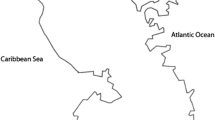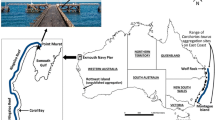Abstract
Cookiecutter sharks are pelagic ectoparasites that feed on pieces of flesh from large marine animals. Knowledge on these sharks is still rather scant, with the few existing works successfully using bites found on prey to reveal ecological patterns. This study aims to identify cookiecutter shark bite patterns on pelagic fishes in aggregated schools to gain an understanding of the ecology of these sharks. Data were collected by accompanying landings and onboard in tuna fishing vessels in the western equatorial Atlantic Ocean off Brazil. A total of 138 bite wounds were found on the bigeye tuna (Thunnus obesus), common dolphinfish (Coryphaena hippurus), skipjack tuna (Katsuwonus pelamis), and yellowfin tuna (Thunnus albacares). The most bitten species were the bigeye and yellowfin tuna, together accounting for 85% of all bites. Our findings offer novel insights into ectoparasitic ecology between cookiecutter sharks and pelagic fishes, identifying three major patterns: (i) preference of the sharks for the ventral surface of pelagic fishes; (ii) plasticity in biting tactics, with both bottom-up and lateral attacks; and (iii) habitat-dependent bite incidence (larger sharks commonly bite the skipjack tuna in epipelagic zones, whereas smaller sharks predominantly bite the bigeye tuna in mesopelagic zones). These results contribute to narrowing the gaps in knowledge on the ecology of the elusive, dwarf cookiecutter sharks. Further studies are needed for a better understanding of how shark-pelagic fish interactions are affected by the fishing of aggregated schools.






Similar content being viewed by others
Data availability
Data is available from the corresponding author on reasonable request.
References
Best PB, Photopoulou T (2016) Identifying the “demon whale-biter”: patterns of scarring on large whales attributed to a cookie-cutter shark Isistius sp. PLoS ONE 11(4):e0152643. https://doi.org/10.1371/journal.pone.0152643
Bornatowski H, Wedekin LL, Heithaus MR, Marcondes MCC, Rossi-Santos MR (2012) Shark scavenging and predation on cetaceans at Abrolhos Bank, eastern Brazil. J Mar Biolog Assoc 92(8):1767–1772. https://doi.org/10.1017/S0025315412001154
Carlisle AB, Allan EA, Kim SL, Meyer L, Port J, Scherrer S, O’Sullivan J (2021) Integrating multiple chemical tracers to elucidate the diet and habitat of Cookiecutter Sharks. Sci Rep 11:11809. https://doi.org/10.1038/s41598-021-89903-z
Castro J, Anllo T, Mejuto J, Garcia B (2018) Ichnology applied to the study of Cookiecutter shark (Isistius brasiliensis) biogeography in the Gulf of Guinea. Environ Biol Fishes 101:579–588. https://doi.org/10.1007/s10641-018-0720-8
Compagno LJV, Dando M, Fowler S (2005) Sharks of the world. Princeton University Press, Princeton
Delroisse J, Duchatelet L, Flammang P, Mallefet J (2021) Photophore distribution and enzymatic diversity within the photogenic integument of the cookie-cutter shark Isistius brasiliensis (Chondrichthyes: Dalatiidae). Front Mar Sci 8:627045. https://doi.org/10.3389/fmars.2021.627045
Feunteun A, Schrevel C, Verhaegen M, Chevallier D, Duchemin M, Ziani N, Montgolfier B (2018) First evaluation of the cookiecutter-sharks (Isistius sp.) predation pattern on different cetacean species in Martinique. Environ Biol Fishes 101(5):749–759. https://doi.org/10.1007/s10641-018-0735-1
Gadig OBF (2001) Tubarões da costa brasileira. PhD thesis, Universidade Estadual Paulista, UNESP.
Grace MA, Dias LA, Maze-Foley K, Sinclair C, Mullin KD, Garrison L, Noble L (2018) Cookiecutter shark bite wounds on cetaceans of the Gulf of Mexico. Aquat Mamm 44(5):491–499. https://doi.org/10.1578/AM.44.5.2018.491
Hoyos-Padilla M, Papastamatiou Y, O’Sullivan J, Lowe CG (2013) Observation of an attack by a cookiecutter shark (Isistius brasiliensis) on a white shark (Carcharodon carcharias). Pac Sci 67(1):129–134. https://doi.org/10.2984/67.1.10
Isouch T (1970) A cigar shark, Isistius brasiliensis from tropical water of the eastern Pacific. Jpn J Ichthyol 17(3):124–125
Jahn AE, Haedrich RL (1987) Notes on the pelagic squaloid shark Isistius brasiliensis. Biol Oceanog 5:297–309
Jones EC (1971) Isitius brasiliensis, a squaloid shark, the probable of crater wounds on fishes and cetaceans. US Fish Bull 69:791–798
Le Boeuf BJ, McCosker JE, Hewitt J (1987) Crater wounds on northern elephant seals: the cookiecutter shark strikes again. US Fish Bull 85:387–392
Menezes R, Cunha-Neto MA, Mesquita GC, Silva GB (2019) Ingestion of macroplastic debris by the common dolphinfish (Coryphaena hippurus) in the Western Equatorial Atlantic. Mar Pollut Bull 141:161–163. https://doi.org/10.1016/j.marpolbul.2019.02.026
Mesquita GC, Menezes R, Cunha-Neto MA, Dantas-Neto AB, Silva GB (2021) Feeding strategy of pelagic fishes caught in aggregated schools and vulnerability to ingesting anthropogenic items in the western equatorial Atlantic Ocean. Environ Pollut 282:117021. https://doi.org/10.1016/j.envpol.2021.117021
Mincarone MM, Lima AT, Soto JMR (2001) Sobre a ocorrência do peixe-fita Trachipterus jacksonensis (Ramsey, 1881) (Lampridiformes, Trachipteridae) na costa brasileira. Mare Magnum 1(2):121–124
Moore M, Steiner L, Jann B (2003) Cetacean surveys in the Cape Verde Islands and the use of cookiecutter shark bite lesions as a population marker for fin whales. Aquat Mamm 29(3):383–389
Muñoz-Chápuli R, Salgado JCR, Serna JMS (1988) Biogeography of Isistius brasiliensis in the North-Eastern Atlantic, inferred from crater wounds on swordfish (**phias gladius). Mar Biol Assoc UK 68:315–321. https://doi.org/10.1017/S0025315400052218
Nakano H, Tabuchi M (1990) Occurrence of the Cookiecutter Shark Isistius brasiliensis in surface waters of the North Pacific Ocean. Jpn J Ichthyol 37(1):60–63
Niella Y, Duarte LAG, Bandeira VR, Crespo O, Beare D, Hazin FHV (2018) Cookie-cutter shark Isistius spp. predation upon different tuna species from the south-western Atlantic Ocean. J Fish Biol 92(4):1082–1089. https://doi.org/10.1111/jfb.13569
Pacoureau N, Rigby CL, Kyne PM, Sherley RB, Winker H, Carlson JK, Fordham SJ, Barreto R, Fernando D, Francis MP, Jabado RW, Herman KB, Liu K-M, Marshall AD, Pollom RA, Romanov EV, Simpfendorfer CA, Yin JS, Kindsvater HK, Dulvy NK (2021) Half a century of global decline in oceanic sharks and rays. Nature 589(7843):567–571. https://doi.org/10.1038/s41586-020-03173-9
Papastamatiou YP, Wetherbee BM, O’Sullivan J, Goodmanlowe GD, Lowe CG (2010) Foraging ecology of Cookiecutter Sharks (Isistius brasiliensis) on pelagic fishes in Hawaii, inferred from prey bite wounds. Environ Biol Fishes 88:361–368. https://doi.org/10.1007/s10641-010-9649-2
Pérez-Zayas JJ, Mignucci-Giannoni AA, Toyos-González GM, Rosario-Deleste RJ, Williams-Jr EH (2002) Incidental predation by a largetooth cookiecutter shark on a Cuvier’s beaked whale in Puerto Rico. Aquat Mamm 28(3):308–311
Petean FF, Carvalho MR (2018) Comparative morphology and systematics of the cookiecutter sharks, genus Isistius Gill (1864) (Chondrichthyes: Squaliformes, Dalatiidae). PLoS ONE 13(8):e0201913. https://doi.org/10.1371/journal.pone.0201913
Ruiz-Abierno A, Rojas-Corvo A, Angulo-Valdés JA (2016) Primer reporte de tiburón cigarro (Isistius brasiliensis) para aguas Cubanas. Rev Investig Mar 36(1):158–161
Saito H, Ishihara K, Murase T (1996) Effect of prey fish lipids on the docosahexaenoic acid content of total fatty acids in the lipid of Thunnus albacares yellowfin tuna. Biosci Biotechnol Biochem 60(6):962–965. https://doi.org/10.1271/bbb.60.962
Saito H, Ishihara K, Murase T (1997) The fatty acid composition in tuna (Bonito, Euthynnus pelamis) caught at three different localities from tropics to temperate. J Sci Food Agric 73:53–59. https://doi.org/10.1002/(SICI)1097-0010(199701)73:1%3c53::AID-JSFA707%3e3.0.CO;2-5
Schaefer KM, Fuller DW, Block BA (2009) Vertical movements and habitat utilization of skipjack (Katsuwonus pelamis), yellowfin (Thunnus albacares), and bigeye (Thunnus obesus) tunas in the equatorial eastern Pacific Ocean, ascertained through archival tag data. In Tagging and tracking of marine animals with electronic devices. Springer, Dordrecht, pp 121–144
Shirai S, Nakaya K (1992) Functional morphology of feeding apparatus of the cookie-cutter shark, Isistius brasiliensis (Elasmobranchii, Dalatiinae). Zool Sci 9:811–821
Silva GB, Hazin HG, Araújo PVAN (2018) Fishing operations to catch tuna on aggregated schools at the vicinity of a data buoy in the Western Equatorial Atlantic. Braz J Oceanogr 66:335–338. https://doi.org/10.1590/s1679-87592018018206604
Silva GB, Hazin HG, Hazin FHV, Vaske-Jr T (2019) Diet composition of bigeye tuna (Thunnus obesus) and yellowfin tuna (Thunnus albacares) caught on aggregated schools in the western equatorial Atlantic Ocean. J Appl Ichthyol 35:1111–1118. https://doi.org/10.1111/jai.13949
Soto JMR, Mincarone MM (2004) Collections of the Museu Oceanográfico do Vale do Itajaí. I. Catalog of cartilaginous fishes (Myxini, Cephalaspidomorphi, Elasmobranchii, Holocephali). Mare Magnum 2(1–2):1–125
Souto LRA, Oliveira JGA, Nunes JACC, Nogueira RM, Sampaio CLS (2007) Análise das mordidas de tubarões-charuto, Isistius spp. (Squaliformes: Dalatiidae) em cetáceos (Mammalia: Cetacea) no litoral da Bahia, Nordeste do Brasil. Biotemas 20(1):19–25
Souto LRA, Abrão-Oliveira JG, Maia-Nogueira R, Dórea-Reis LW (2009) Interactions between subantarctic fur seal (Arctocephalus tropicalis) and cookiecutter shark (Isistius plutodus) in the coast of Bahia, north-east of Brazil. Mar Biodivers Rec 2:e123. https://doi.org/10.1017/S1755267209000992
Stehman MFW, Kukuev EI (2015) Two southeastern Atlantic records of the rare largetooth cookiecutter shark, Isistius plutodus (Selachii, Squaliformes, Dalatiidae). Cybium 39(1):73–77. https://doi.org/10.26028/cybium/2015-391-009
Stump KL, Crooks CJ, Fitchett MD, Gruber SH, Guttridge TL (2017) Hunted hunters: an experimental test of the effects of predation risk on juvenile lemon shark habitat use. Mar Ecol Prog Ser 574(85):95. https://doi.org/10.3354/meps12187
Tomás ARG, Gomes UL (1989) Observações sobre a presença de Cetorhinus maximus (Gunnerus, 1765) (Elasmobranchi, Cetorhinidae) no sudeste e sul do Brasil. Bol Inst Pesca 16(1):111–116
Vaske-Jr T, Travassos PE, Hazin FHV, Tolotti MT, Barbosa TM (2012) Forage fauna in the diet of bigeye tuna (Thunnus obesus) in the western tropical Atlantic Ocean. Braz J Oceanogr 60:89–97. https://doi.org/10.1590/S1679-87592012000100009
Widder EA (1998) A predatory use of counterillumination by the squaloid shark, Isistius brasiliensis. Environ Biol Fishes 53:267–273. https://doi.org/10.1023/A:1007498915860
Acknowledgements
We thank L.O.S. Rebouças, M.A. Cunha-Neto, and all fishermen for the field assistance during the onboard trips. We also thank F.V. Albuquerque, J.M. Figueiredo-Filho, R.S. Rosa, and two anonymous reviewers for their valuable contributions to the article. R.M. is grateful to the CAPES Foundation for the Ph.D. scholarship.
Author information
Authors and Affiliations
Contributions
All authors contributed to the study conception and design. Material preparation and data collection were performed by Rafael Menezes, João Paulo Dantas Marinho, and Guelson Batista Silva. Data analysis and visualization were performed by Rafael Menezes, Grazielly Campos de Mesquita, and Guelson Batista Silva. The first draft of the manuscript was written by Rafael Menezes, supervised by Guelson Batista Silva, and all authors reviewed the subsequent versions. All authors read and approved the final version of the manuscript.
Corresponding author
Ethics declarations
Conflict of interest
The authors declare no competing interests.
Additional information
Publisher's note
Springer Nature remains neutral with regard to jurisdictional claims in published maps and institutional affiliations.
Supplementary Information
Below is the link to the electronic supplementary material.
Rights and permissions
About this article
Cite this article
Menezes, R., Marinho, J.P.D., de Mesquita, G.C. et al. Cookiecutter shark (Isistius spp.) bite patterns on pelagic fishes in aggregated schools in the western equatorial Atlantic Ocean. Environ Biol Fish 105, 519–530 (2022). https://doi.org/10.1007/s10641-022-01257-1
Received:
Accepted:
Published:
Issue Date:
DOI: https://doi.org/10.1007/s10641-022-01257-1




